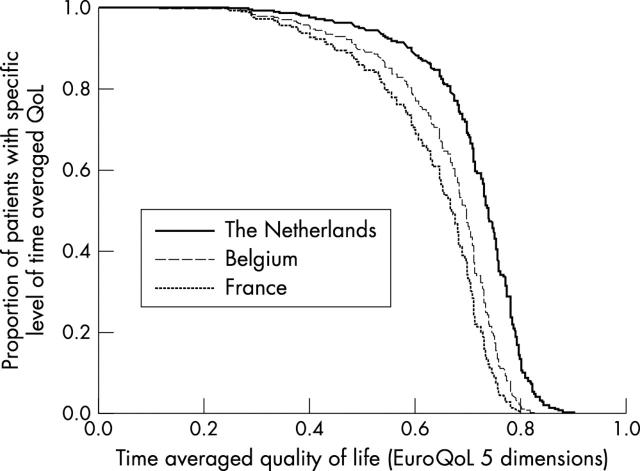Abstract
Objective: To assess a patient's out of pocket costs, income loss, time consumption, and quality of life (QoL) due to ankylosing spondylitis (AS) in three European countries and to assess variables predicting these outcomes.
Methods: 216 patients with AS from the Netherlands, France, and Belgium participated in a two year study. Health resource use, days absent from work, time lost, and quality of life (EuroQol) were assessed by bimonthly questionnaires. AS related healthcare and non-healthcare expenditure and income loss were calculated taking into account country-specific regulations. Predictors of costs, time consumption, and QoL were analysed by Cox's regression.
Results: 209 patients provided data for cost analysis. Average annual healthcare and non-healthcare expenditure was €431 per patient and average annual income loss was €1371 per patient. Healthcare costs were highest for Belgian and lowest for French patients, while non-healthcare costs were highest for Dutch patients. A patient's total costs were associated with higher age and worse physical function. On average, patients with AS needed 75 minutes additional time a day because of AS. Worse physical function and higher disease activity predicted time consumption. After adjusting for baseline confounders, QoL was worse in Belgian and French than in Dutch patients. Peripheral arthritis, worse physical function, higher disease activity, and loss of income contributed to worse QoL.
Conclusion: AS is time consuming and associated with substantial out of pocket costs. Belgian patients incur the highest healthcare payments. Poor physical function increases patient's costs and time consumption. Loss of income is associated with lower QoL.
Full Text
The Full Text of this article is available as a PDF (207.5 KB).
Figure 1.
Survival curve illustrating the proportion of patients reporting a specific level of quality of life (QoL) for each country separately.
Selected References
These references are in PubMed. This may not be the complete list of references from this article.
- Albers J. M., Kuper H. H., van Riel P. L., Prevoo M. L., van 't Hof M. A., van Gestel A. M., Severens J. L. Socio-economic consequences of rheumatoid arthritis in the first years of the disease. Rheumatology (Oxford) 1999 May;38(5):423–430. doi: 10.1093/rheumatology/38.5.423. [DOI] [PubMed] [Google Scholar]
- Boonen A., van der Heijde D., Landewé R., Spoorenberg A., Schouten H., Rutten-van Mölken M., Guillemin F., Dougados M., Mielants H., de Vlam K. Work status and productivity costs due to ankylosing spondylitis: comparison of three European countries. Ann Rheum Dis. 2002 May;61(5):429–437. doi: 10.1136/ard.61.5.429. [DOI] [PMC free article] [PubMed] [Google Scholar]
- EuroQol Group EuroQol--a new facility for the measurement of health-related quality of life. Health Policy. 1990 Dec;16(3):199–208. doi: 10.1016/0168-8510(90)90421-9. [DOI] [PubMed] [Google Scholar]
- Lapsley H. M., March L. M., Tribe K. L., Cross M. J., Courtenay B. G., Brooks P. M., Arthritis Cost and Outcome Project Group Living with rheumatoid arthritis: expenditures, health status, and social impact on patients. Ann Rheum Dis. 2002 Sep;61(9):818–821. doi: 10.1136/ard.61.9.818. [DOI] [PMC free article] [PubMed] [Google Scholar]
Associated Data
This section collects any data citations, data availability statements, or supplementary materials included in this article.



